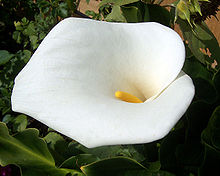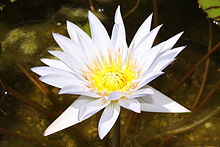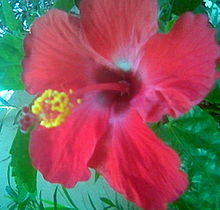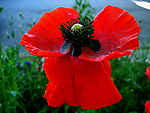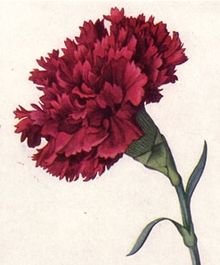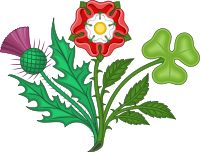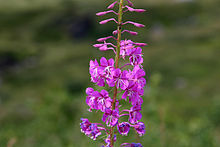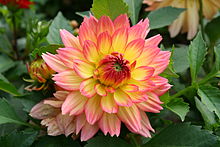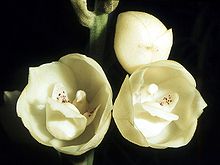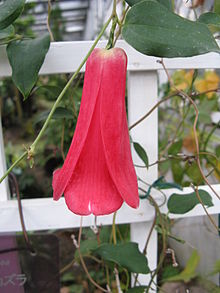- Floral emblem
-
In a number of countries, plants have been chosen as symbols to represent specific geographic areas. Some countries have a country-wide floral emblem; others in addition have symbols representing subdivisions. Different processes have been used to adopt these symbols - some are conferred by government bodies, whereas others are the result of informal public polls. The term floral emblem, which refers to flowers specifically, is primarily used in Australia and Canada. In the United States, the term state flower is more often used.
Africa
Egypt
- Egypt – Lotus this is the national flow
Ethiopia
- Ethiopia - Calla lily
Lesotho
- Lesotho -
Liberia
- Liberia - Pepper
Mauritius
- Mauritius – Trochetia boutoniana (Boucle d'Oreille)[1]
Namibia
- Namibia – Welwitschia mirabilis
Nigeria
- Nigeria - Costus spectabilis
South Africa
- South Africa – King protea
Tunisia
- Tunisia - Jasmine (Jasminum grandiflorum)
Zimbabwe
- Zimbabwe – Flame lily
Asia
Bangladesh
The national flower and national emblem of Bangladesh is the Shapla (Bangla: শাপলা)] or White Water Lily Nymphaea nouchali)[2] See also: National Emblem of Bangladesh.
Bhutan
- Bhutan - Blue poppy (Meconopsis grandis)
Brunei
- Brunei – Simpor (Dillenia suffruticosa)[3]
Cambodia
- Cambodia – Romduol (Mitrella mesnyi[3]) (Although the term romduol may also refer to Melodorum fruticosum)[4]
China
China currently has no official national flower. Traditionally, various regions have different designations where national symbols are concerned.
In 1903, the Qing Dynasty named the peony (Paeonia suffruticosa) the floral emblem of the nation. The peony has long been considered a flower of wealth and honor in China.
The plum blossom meihua (Chinese: 梅花; pinyin: méihuā) has been long held as one of the most beloved flowers in Chinese culture. The Republic of China government named the plum blossom as the national flower in 1964.[5] The plum blossom is symbol for resilience and perseverance in the face of adversity, because plum blossoms often bloom most vibrantly even amidst the harsh winter snow.[5][6][7]
The People's Republic of China, which has controlled mainland China since 1949, has no official floral emblem. There have been several petitions in recent years to officially adopt one. However, the government has not taken any action yet. A poll in 2005 showed that 41% of the public supports peony as the national flower while 36% supported the plum blossom.[8] Some scholars have suggested that the peony and plum blossoms may be designated as dual national flowers. The orchids and chrysanthemum have also been held as possible floral symbols of China, along with the peony and plum blossoms.
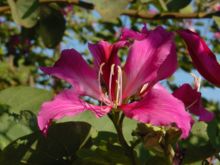 Bauhinia blakeana, the floral emblem of Hong Kong
Bauhinia blakeana, the floral emblem of Hong Kong
Hong Kong
The Bauhinia blakeana, a native species discovered in Hong Kong, is the floral emblem of that territory.
It was chosen as the logo of the Urban Council in 1965, and it was later incorporated in the flag and emblem of the Hong Kong Special Administrative Region of the People's Republic of China after the 1997 handover of Hong Kong from the United Kingdom to the People's Republic of China.
Macau
The flower representing Macau is lotus, a stylised depiction of which can be seen in the territory's flag.
India
The flower of India is also the Lotus (Nelumbo nucifera). The reason this flower was chosen is because it signifies that which keeps itself pure even when living in a rough environment.[9]
Kerala's state floral emblem is Cassia fistula. Tamil Nadu's floral emblem is Glory lily. Water Lily is the state flower of Andhra Pradesh. Bihar's floral emblem is Kachnaar and that of Uttarakhand is Rhododendron.
Indonesia
Main article: List of Indonesian floral emblemsThere are three categories of floral emblem that symbolize Indonesia; puspa bangsa (national flower) of Indonesia is Melati (Jasminum sambac), puspa pesona (flower of charm) is Anggrek Bulan (Moon Orchid) (Phalaenopsis amabilis[3]) and puspa langka (rare flower) is Padma Raksasa Rafflesia (Rafflesia arnoldii). All three were chosen on World Environment Day in 1990.[10] and enforced by law through Presidential Decree (Keputusan Presiden) No. 4 1993,[11] On the other occasion Bunga Bangkai (Titan arum) was also added as puspa langka together with Rafflesia.
Melati (jasminum sambac), a small white flower with sweet fragrance, has long been considered as a sacred flower in Indonesian tradition, as it symbolizes purity, sacredness, graceful simplicity and sincerity. For example, on her wedding day, a traditional Indonesian bride's hair is often adorned with arrangements of jasmine, while the groom's kris is often adorned with a lock of jasmine. However, jasmine is also often used as floral offering for spirits and deities, and also often present during funerals which gave it its mystical and sacred properties. Moon Orchid was chosen for its beauty, while the other two rare flowers, Rafflesia arnoldii and Titan arum were chosen to demonstrate uniqueness and Indonesian rich biodiversity.
Each of the 33 Provinces of Indonesia also have native plants used as floral emblems.
Iran
- Iran – Tulip (depicted on the Flag of Iran)
Iraq
- Iraq – Rose
Israel
The Israeli floral emblem is the Rakefet (Cyclamen; רקפת in Hebrew)
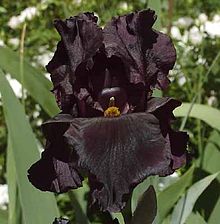 Black iris, national flower of Jordan
Black iris, national flower of Jordan
Jordan
- Jordan – Black iris (Iris chrysographes)
Japan
Japan's national government has never formally named a "national flower", as with other symbols such as the green pheasant, which was named as national bird (by a non-government body) in 1947, but it wasn't until 1999 that the national flag and national anthem were officially passed into law.
A de facto national flower for Japan for many is the sakura or cherry blossom, while a stylised picture of a chrysanthemum is used as the official seal of the Japanese Imperial Family.
North Korea
- Magnolia, Nonazhreea makenna Mamariaia
South Korea
- South Korea – Hibiscus syriacus (Rose of Sharon)
Kuwait
- Kuwait – Rhanterium epapposum
Laos
Laos national flower is the Plumeria (champa),[3] despite it being no longer endemic.
Malaysia
The national flower of Malaysia is the Bunga Raya (Chinese Hibiscus, Hibiscus rosa-sinensis).[3][12]
The flower of the Eastern Malaysian state of Sarawak is the Phalaenopsis bellina, while that of the state of Kedah is the pokok padi.
Maldives
Myanmar
- Myanmar – Pterocarpus indicus (paduak)[3]
Nepal
- Nepal – Rhododendron
Pakistan
The National symbols of the country constituting the nation-state such as the Poet's Jasmine (National flower of Pakistan) and Rhododendron the (State flower) and the Chinar (State tree) in the Regional state of Jammu and Kashmir (disputed territory), Deodar (National tree of Pakistan), Mango (National fruit of Pakistan),
Unofficial provincial floral emblems of Pakistan
The Provincial floral emblems of Pakistan are the symbols of the four constituting provinces of the nation-state; however they are all unofficial and are not recognised by the new Government of Pakistan.
- Islamabad Capital Territory - Paper Mulberry (unofficial Territorial tree) and the Rose (unofficial Territorial flower)
- Balochistan (Pakistan) - Date palm (unofficial Provincial tree) and Ephedra (genus) (unofficial Provincial flower)
- Khyber Pakhtunkhwa - Juniperus squamata (unofficial Provincial tree) and Morina (unofficial Provincial flower)
- Punjab (Pakistan) - Dalbergia sissoo (unofficial Provincial tree) and Justicia adhatoda (unofficial Provincial flower)
- Sindh - Prosopis cineraria (unofficial Provincial tree) and Water hyacinth (unofficial Provincial flower)
Also See: National Emblem of Pakistan.[14]
The Philippines
The Philippines adopted the Sampaguita (Arabian jasmine, Jasminum sambac) as its national flower because it symbolises purity and cleanliness due to its colour and sweet odour.[3]
Singapore
The national flower for Singapore is the orchid Vanda Miss Joaquim.
Sri Lanka
Sri Lanka - Nil Mānel, Water Lily (Nymphaea stellata).[15][16] Although "Nil" means ‘blue’ in Sinhala, the Sinhalese name of this plant is often rendered as " Water Lily" in English.
This beautiful aquatic flower appears in the Sigiriya frescoes and has been mentioned in Sanskrit, Pali and Sinhala literary works since ancient times under the names "Kuvalaya", "Indhīwara", "Niluppala", "Nilothpala" and "Nilupul" as a symbol of virtue, discipline and purity. Buddhist lore in Sri Lanka claims that this flower was one of the 108 auspicious signs found on Prince Siddhartha's footprint.[17][18]
Republic of China (Taiwan)
The National Flower was officially designated as the plum blossom by the Executive Yuan of the Republic of China on July 21, 1964.[5] The plum blossom, known as the meihua (Chinese: 梅花; pinyin: méihuā), is symbol for resilience and perseverance in the face of adversity, because plum blossoms often bloom most vibrantly even amidst the harsh winter snow.[7][6] The triple grouping of stamens represents Dr. Sun Yat-sen's Three Principles of the People, while the five petals symbolize the five branches of the government.[5][6]
Thailand
The national flower for Thailand is Golden Shower Tree, locally called dok khuen or Rachapruek[3]
Vietnam
Eurasia
Armenia
- Armenia – [National Flower's of Armenia, Althaea Armeniaca, Armenian Basket, Muscari Armeniacum, Armenian Poppy, Armenian Vartig (Vargit Flower), Paphiopedilum Armeniacum, Tulipa Armena ] Apricot (Prunus Armeniaca], Pomegranate and [Rubus Armeniacus], which symbolizes fertility in Armenian belief.
Cyprus
- Cyprus – Cyprus cyclamen
Russia
Soviet Union
Turkey
- Turkey – Tulip
Europe
Albania
The floral emblem of Albania is the red and black poppy. The poppy can be found everywhere in this Illyrian country, and are recognized for their beauty, medicinal value, and seeds, though they originate from Anatolia.
Austria
- Austria - Alpine gentian (German: Enzian), edelweiss
Belarus
- Belarus - Centaurea (unofficial)
Bosnia and Herzegovina
- Bosnia and Herzegovina - Lilium bosniacum
Bulgaria
- Bulgaria – Rose
Croatia
- Croatia – Iris croatica, Degenia velebitica, Oak, Tilia
Czech Republic
- Czech Republic - Tilia cordata
Denmark
- Denmark – Red clover
Estonia
- Estonia - cornflower
Finland
- Finland – Lily of the valley, white rose
France
The Iris is the national flower of France as represented in Fleur-de-lis emblem, the symbol of French monarchy.
Germany
- Germany – Cornflower, oak
Greece
- Greece - Laurel branch
Iceland
- Iceland – (Dryas octopetala)[19]
Ireland
- The shamrock (or trefoil) is widely used as an unofficial symbol for Ireland.
County flowers in Ireland
- Bog-rosemary is the county flower of County Offaly[20]
Italy
Latvia
- Latvia - oxeye daisy[21]
Lithuania
- Lithuania - Rue
Macedonia
- Republic of Macedonia - Poppy
Malta
- Malta – Maltese Rock Centaury, Widnet il-Baħar
Netherlands
- Netherlands – Tulip
Norway
- Norway – Heather–[disambiguation needed
 ] Saxifraga cotyledon
] Saxifraga cotyledon
County Flowers of Norway
- Lily-of-the-valley was chosen as the county flower of Østfold[22]
- Globe flower is the county flower of Troms[23]
Poland
- Poland – Corn poppy
Portugal
- Portugal - Lavender, Olive leaves, Cork Oak, Red Carnation, Sunflower and Blue-White Hydrangea
Romania
- Romania - Dog Rose, Edelweiss, Romanian Peony
Russia
- Russia - Chamomile
Serbia
Slovakia
- Slovakia - Tilia cordata
Slovenia
- Slovenia – Carnation[citation needed], Linden[disambiguation needed
 ] leaf
] leaf
Spain
- Spain – Carnation
The national flower of Spain is considered to be the carnation, in Spanish clavel. Essentially it's associated with Spanish folklore, especially from southern Spain, or Andalusia.
In any case, it's not only related to the more seedy side of Spain, like gipsy's lapels or thrown into the bullringruedos, but it's also associated with Renacentist a symbol of affection between lovers[24] and especially as a religious symbol related to the Jesus passion that represents the Crown of Thorns (Clavos de Cristo).
It comes from the catalan language word for clove: "clavell" because the carnation also has a nice fragrant aroma, as does this spice.
In Spain and America it symbolizes passion, and it's a very expressive gesture to bite its stem and hold the clavel between one's teeth. In the Spanish language of flowers represents caprice[disambiguation needed
 ], passion, wish and desire.
], passion, wish and desire.Subnational flowers of Spain
Sweden
Sweden has no national floral emblem, however, each of the traditional provinces has a province flower.
Province flowers of Sweden
Main article: Province flowers of SwedenSwitzerland
- Switzerland – Edelweiss, alpenrose (Rhododendron ferrugineum), alpine gentian (Gentiana alpina)
Ukraine
United Kingdom
Each of the four countries of the United Kingdom has a traditional floral emblem. For England this is officially the Tudor rose[26] or unofficially the red rose and English Oak; in Northern Ireland the flax, orange lily, or shamrock;[citation needed] in Scotland the thistle, Scottish bluebell (harebell) or heather; and in Wales the daffodil, leek or sessile oak.
County flowers in the United Kingdom
See also: County flowers of the United KingdomA county flower is a flowering plant chosen to symbolise a county. They exist primarily in the United Kingdom, but some counties in other countries also have them.
One or two county flowers have a long history in England - the Red rose of Lancashire dates from the Middle Ages, for instance. However, the county flower concept was only extended to cover the whole United Kingdom in 2002, as a promotional tool by a charity. In that year, the plant conservation charity Plantlife ran a competition to choose county flowers for all counties, to celebrate the Golden Jubilee of Queen Elizabeth II.
Plantlife's scheme is loosely based on Britain's historic counties, and so some current local government areas are not represented by a flower, and some of the counties included no longer exist as administrative areas. Flowers were also chosen for thirteen major cities: Belfast, Birmingham, Bristol, Cardiff, Edinburgh, Glasgow, Leeds, Liverpool, London, Manchester, Newcastle upon Tyne, Nottingham and Sheffield. The Isles of Scilly was also treated as a county (distinct from Cornwall) for the purpose of the scheme. The Isle of Man was included, but not the Channel Islands.
A total of 94 flowers was chosen in the competition. 85 of the 109 counties have a unique county flower, but several species were chosen by more than one county. Foxglove or Digitalis purpurea was chosen for four counties - Argyll, Birmingham, Leicestershire and Monmouthshire - more than any other species. The following species were chosen for three counties each:
- Bog Rosemary Andromeda polifolia (Cardiganshire, Kirkcudbright and Tyrone)
- Cowslip Primula veris (Northamptonshire, Surrey and Worcestershire)
- Harebell Campanula rotundifolia (Antrim, Dumfriesshire and Yorkshire)
- Thrift Armeria maritima (Buteshire, Pembrokeshire and the Isles of Scilly)
And the following species were chosen for two counties:
- Grass-of-parnassus Parnassia palustris (Cumberland and Sutherland)
- Pasqueflower Pulsatilla vulgaris (Cambridgeshire and Hertfordshire)
- Common Poppy Papaver rhoeas (Essex and Norfolk)
In addition, Sticky Catchfly Lychnis viscaria was chosen for both Edinburgh and Midlothian, the county containing Edinburgh.
For most counties, native species were chosen, but for a small number of counties, non-natives were chosen, mainly archaeophytes. For example Hampshire has a Tudor Rose as it's county flower even though it is not a native species.
North America
Antigua and Barbuda
The national flower of Antigua and Barbuda is Agave karatto, also known as Dagger Log or Batta Log.[27]
The Bahamas
The national flower of The Bahamas is the Yellow Elder (Tecoma stans).[28]
Barbados
The national flower of Barbados is the known locally as the Pride of Barbados (Caesalpinia pulcherrima).[29]
Belize
The national flower of Belize is the Black Orchid (Prosthechea cochleata)[30]
Canada
The maple leaf is widely used as a symbol for Canada. Many Canadian flags and coat of arms have floral emblems on them. The Flag of Montreal has four floral emblems. On the right side of the Flag of Saskatchewan overlapping both green and gold halves is the western red lily, the provincial floral emblem. The Coat of Arms of Port Coquitlam has the City's floral emblem, the azalea displayed on a collar. The Coat of Arms of Prince Edward Island displays Lady's Slippers, the floral emblem of the Island. The Coat of Arms of Nova Scotia has the trailing arbutus or mayflower, the floral emblem of Nova Scotia, added when the arms were reassumed in 1929.
Alberta
British Columbia
- British Columbia - Pacific Dogwood
Manitoba
New Brunswick
Newfoundland and Labrador
- Newfoundland and Labrador - The Pitcher Plant was officially declared as the provincial flower in 1954 but had appeared on the colony's coinage as early as the 1880s. It can be found in the marshlands of the province feeding on insects that fall into its leaves and drown.
Northwest Territories
Nova Scotia
Ontario
Prince Edward Island
Quebec
- Quebec – The Blue Flag Iris replaced the Madonna Lily in 1999 since the lily was not native to Quebec.
Saskatchewan
Yukon
Costa Rica
- Costa Rica - "Guaria morada", Guarianthe skinneri
Cuba
- Cuba - "Mariposa" "Butterfly", Hedychium coronarium
Dominica
- Dominica - Caribwood or Bois Kwaib (Poitea carinalis)
Dominican Republic
The Dominican Republic's national flower is the Caoba [Swietenia mahagoni] or Mahogany tree flower.
El Salvador
The national flower of El Salvador is Flor de Izote
Guatemala
- Monja Blanca, (White Lycaste skinneri)
Honduras
- Orquídea Brassavola, (Rhyncholaelia)
Jamaica
Jamaica – Lignum Vitae (Guaiacum officinale). And the national tree is the Blue Mahoe.
Mexico
- Mexico – Dahlia
Nicaragua
Nicaragua's national flower is the Sacuanjoche (Plumeria alba), and was declared the country's national flower on August 17, 1971. Its name is derived from Nicarao, the name of the Nahuatl-speaking tribe which inhabited Nicaragua; "xacuan"(sacuan) means beautiful yellow petals and "xochilt"(joche) means flower. The flower can be found in the Masaya Volcano National Park among other places.
Panama
Panama's national flower is the Holy Ghost Orchid or La Flor del Espiritu Santo (Peristeria elata). It is best known for its ivory color petals, and beautiful blossoms.
Saint Kitts and Nevis
- Saint Kitts and Nevis - Red Royal Poinciana
Trinidad and Tobago
- Trinidad and Tobago - Chaconia (Warszewiczia coccinea)
United States
See also: List of U.S. state flowers and List of U.S. state treesIn 1986 President Ronald Reagan signed legislation to make the rose the floral emblem of the United States.[32] In the United States, state flowers and state trees have been adopted as symbols by state legislatures. (Lewis Mumford once remarked that “Our national flower is the concrete cloverleaf”.)
Oceania
Australia
The floral emblem of Australia is the Golden Wattle (Acacia pycnantha).
- State flowers of Australia
Main article: List of Australian floral emblems- Australian Capital Territory - Royal Bluebell (Wahlenbergia gloriosa)
- New South Wales - New South Wales Waratah (Telopea speciosissima)
- Northern Territory - Sturt's Desert Rose (Gossypium sturtianum)
- Queensland - Cooktown Orchid (Dendrobium phalaenopsis)
- South Australia - Sturt's Desert Pea (Swainsona formosa)
- Tasmania - Tasmanian Blue Gum (Eucalyptus globulus)
- Victoria – Pink (Common) Heath (Epacris impressa)
- Western Australia – Red and Green Kangaroo Paw (Anigozanthos manglesii)
Fiji
The national flower is "Tagimaucia" (Medinilla waterhousei), a vine with red and white flowers endemic to the highlands of the island of Taveuni.
New Zealand
The "Silver Fern" (foliage) is acknowledged as a national emblem in New Zealand. Other plant emblems are: Koru (a curled fern symbol), Kowhai (Sophora spp., native trees with yellow cascading flowers) and the crimson-flowered Pohutukawa (Metrosideros excelsa) also called New Zealand's Christmas tree.
Tonga
The "Heilala" (Garcinia sessilis), is Tonga's national flower. The name of Tonga's most popular beauty pageant, the Heilala Festival, is taken from this flower. Resorts as well as products are also often named after this flower such as the Heilala Lodge and Heilala Vanilla. The flower is also used in Tonga for medicinal and ornamental purposes.
South America
Argentina
The national flower of Argentina is the flower of the ceibo tree, also known as seibo or bucaré (Erythrina crista-galli)[33]
Bolivia
Bolivian national flowers are Kantuta (Catua buxifolia) and patujú (Heliconia rostrata)
Brazil
The nation flower of Brazil is the Tabebuia alba flower.
Chile
- Chile – Copihue
Colombia
Cattleya trianae is the national flower of Colombia and is the Orchid which flowers in May. The May flower was chosen because the colors are the same as those of the Colombian flag.
Ecuador
Ecuador's national flower is the Rose.
Guyana
- Guyana - Victoria regia lily
Peru
The national flower of Peru is the Cantuta (often spelled Kantuta or Qantuta, from Quechua qantu)(cantua buxifolia). It can be found at the high valleys of the Andean territory, in Peru and Bolivia.
Uruguay
- Uruguay – Ceibo
Venezuela
- Venezuela – "Flor de Mayo" (Cattleya mossiae) (orchid)
References
- ^ http://www.gov.mu/portal/site/abtmtius?content_id=7c690d31693c8010VgnVCM100000ca6a12acRCRD
- ^ "Constitution of Bangladesh - Chapter I". Archived from the original on 2008-03-30. http://web.archive.org/web/20080330213029/http://www.pmo.gov.bd/constitution/part1.htm. Retrieved 2008-04-09.
- ^ a b c d e f g h i "ASEAN National Flowers". ASEAN. http://www.asean.org/18204.htm. Retrieved 2007-06-08.
- ^ "ROYAL DECREE on Designation of Animals and Plants as National Symbols of the Kingdom of Cambodia". Forestry Administration of Cambodia. http://www.forestry.gov.kh/Documents/ROYAL-DECREE-ENG.pdf. Retrieved 2007-06-08.
- ^ a b c d Government Information Office, Republic of China - National Flower
- ^ a b c National Flag, Anthem and Flower
- ^ a b "The Three Friends of Winter: Paintings of Pine, Plum, and Bamboo from the Museum Collection". Taipei: National Palace Museum (國立故宮博物院). http://www.npm.gov.tw/exh91/3friends/english/infor.htm. Retrieved 31 July 2011.
- ^ 民众呼吁尽快确定国花 梅花还是牡丹引起激辩 (Chinese: The public calls for speedy designation of national flower; debates between plum blossom and peony)
- ^ The Encyclopedia of religion, Volume 9, page-30
- ^ http://www.asean.org/18203.htm
- ^ Keputusan Presiden No. 4 Tahun 1993
- ^ Lian, Michelle. "Hibiscus - Malaysia's national pride". AllMalaysia.info. http://allmalaysia.info/services/printerfriendly.asp?file=/2005/2/28/people/10220245.
- ^ [1]
- ^ "Information of Pakistan". Government of Pakistan. http://www.pak.gov.pk/BasicFacts.aspx. Retrieved 2007-09-29.
- ^ "Sri Lanka National Flower". gov.lk. Government of Sri Lanka. http://www.gov.lk/info/index.asp?mi=19&xp=52&xi=56&xl=3&o=0&t=. Retrieved 2009-05-06.[dead link]
- ^ Zeylanica (Nymphaea stellata)
- ^ TokyoNet - National Statistics
- ^ [2]
- ^ [3]
- ^ http://www.destinations-uk.com/ireland.php?countyid=65
- ^ http://www.li.lv/index.php?Itemid=1065&id=65&option=com_content&task=view
- ^ http://www.ostfold-f.kommune.no/modules/module_123/proxy.asp?D=2&C=377&I=17148
- ^ http://www.tromsofoto.net/troms_county.htm
- ^ Clavel
- ^ http://www.festes.org/arxius/ginestaflornacional.pdf
- ^ National Flowers of the UK, 10 Downing Street. Retrieved 12 May 2009.
- ^ "National Symbols". Government of Antigua & Barbuda. http://www.ab.gov.ag/gov_v2/shared/about_nationalsymbols.html.
- ^ "The Yellow Elder - The National Flower of the Bahamas". The Government of The Bahamas. http://www.bahamas.gov.bs/bahamasweb2/home.nsf/vContentW/4B4E97877E5B54D006256ED00001C3CB!OpenDocument&Highlight=0,elder.
- ^ "The National Flower of Barbados". The Government of Barbados. http://www.gov.bb/portal/page/portal/BIG_Portal_Home_Page/BIG_Homepage_About_Barbados/BIG_HOMEPAGE_National_Information.
- ^ "National Symbols". Government of Belize. Archived from the original on 2007-10-12. http://web.archive.org/web/20071012043935/http://www.governmentofbelize.gov.bz/ab_symbols.html. Retrieved 2008-04-06.
- ^ http://www.pch.gc.ca/pgm/ceem-cced/symbl/101/117-eng.cfm#a6
- ^ National Flower of United States - Fresh from the Grower
- ^ "About Argentina". www.argentina.gov.ar. http://www.argentina.gov.ar/argentina/portal/paginas.dhtml?pagina=1470.
External links
- Plantlife County flowers page
- BBC coverage of the county flowers competition
- Provincial Floral Emblems of Canada
- National Flowers
- List Of National Flowers by Country
National symbols Articles Lists Categories:- Flowers
- National symbols
Wikimedia Foundation. 2010.

